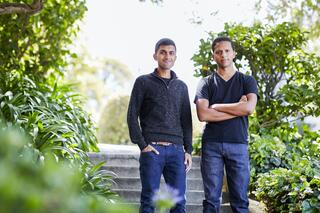Biotech R&D Startup Benchling Hits $4 Billion Valuation As The Company Starts Laying Groundwork For An IPO
2021-05-12
By Amy Feldman

Benchling CEO Sajith Wickramasekara (right) cofounded the company with his MIT classmate Ashu Singhal. COURTESY OF BENCHLING
Sajith Wickramasekara was just 24 when he made the cut for the Forbes 30 Under 30 list for his biotech R&D startup, Benchling. Today, Wickramasekara joins the ranks of unicorn founders as Benchling hits a $4 billion valuation. That valuation—nearly five times what it was worth last May—comes as the company raised $200 million led by Sequoia Capital Global Equities.
“The industry tailwinds have never been stronger,” Wickramasekara, now 30, told Forbes. “It’s not just happening in medicine. It’s also diagnostics, agriculture, food, consumer packaged goods. I look at it as the fourth Industrial Revolution, and I genuinely believe it is going to rewrite life as we know it.”
The new investment brings Benchling total funding to $350 million, and puts the company one step closer to an initial public offering for which Wickramasekara says he’s already begun preparing. Earlier this month, Benchling announced that it had hired its first chief financial officer, Richard Wong, who was previously CFO of Houzz and vice president of finance at LinkedIn, as well as a general counsel and chief information security officer. “We don’t have a firmly committed time line [for an IPO], but we are doing the work to get ready,” Wickramasekara says. “It’s an aspiration for us.”
Back when he was in college at MIT nine years ago, Wickramasekara started working on an idea for a cloud-based Crispr design tool for scientists. He’d studied computer science and had spent time in a biology lab, and was frustrated with how the reliance on paper, email and spreadsheets was holding back research. He and his cofounder, Ashu Singhal, also a student at MIT, started out by giving their software away for free to academic researchers. Singhal is now president of the company.
In the early days, it wasn’t clear what the company’s value might be, and there was a lot of skepticism about software focused on just one vertical. But by last summer, the San Francisco-based company became one of 25 to make the cut for *Forbes'* Next Billion-Dollar Startups list as the coronavirus pandemic put the spotlight on biotech.
Revenue surpassed $50 million last year, double the previous year, and is expected to double again this year. As the company has grown, it’s added new products, including a data and analytics dashboard that helps its customers gain both scientific and operational insights.
“Foundational technologies on biology are being developed, similar to the way they were on the traditional technology side,” says Sequoia’s Patrick Fu, who led the investment. “We are in the early innings of that.”
Today, Benchling counts 450 companies as customers, including Regeneron, Gilead, Sanofi and Corteva Agriscience. These firms use Benchling’s cloud-based platform to help them track, measure and forecast their scientific work. Academic researchers continue to get the product for free, while companies pay anywhere from $15,000 for a small biotech to millions for a large corporation. “There is no one-stop shop,” says Sana Biotechnology CEO Steve Harr, whose firm is a Benchling customer. “The alternative to Benchling is often building it all yourself.”
Jason Ryder, cofounder and chief technology officer of Joywell Foods, which makes foods based on naturally sweet proteins, has been down that path before. So he was relieved to sign on with Benchling just over a year ago, even though, as he says, it’s “not an insignificant expense” for a startup. “The killer story is a great scientist with a great idea, but for sustained success you have to build systems to manage the information and the data,” he says.
With the new funding, Benchling is adding more tools for researchers working with chemistry as well as biology and looking into other products that could support development as well as research. It also plans to increase international operations, including in Europe, where it has already opened a beachhead, and in Asia.
“I remember when it took us, like, 70 meetings to cobble together $500,000,” Wickramasekara says. This time, the company got 20 offers during two weeks of fundraising, he says, allowing it to build a war chest with the new funds and most of the previous two rounds still in the bank. “We didn’t really need the money,” he says. “But we are at an inflection point where we can think about the next ten years.”